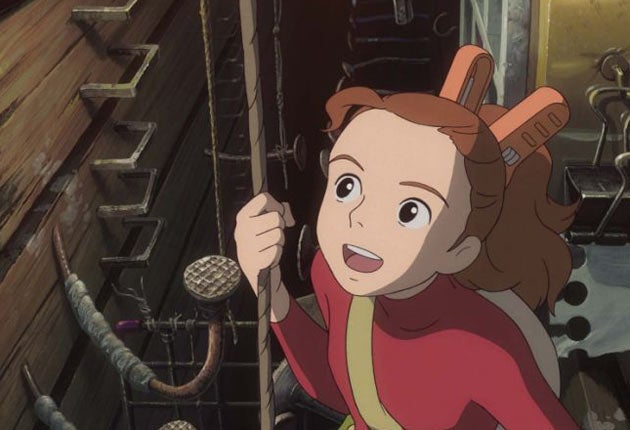Inside the crazy world of anime
The famous Japanese cartoon art comes to life at one very hands-on Tokyo museum. By Danielle Kubo

It's akin to straying into a cartoon. From the sun-drenched yellow walls, to the maze of spiral staircases and mini-sized archways beneath painted-dome ceilings – not to mention the oversized furry cat bus and a towering robot loitering in the roof garden – the scene would not look out of place in a raft of colourful animations. However, it is in fact one of Japan's very real anime gems: the Ghibli museum.
Japan, the birthplace of anime, has been a master of the cartoon artform ever since producing what is believed to be Asia's first animation in 1917. With a style initially inspired by Japanese painting and calligraphy, the nation's prolific cartoon productions began booming in popularity among overseas audiences from the 1980s. Today, it's a huge part of modern Japanese culture. The anime market in Japan was valued at 216.4 billion yen (£1.7bn) in 2009. Anime-lovers – known as otaku in Japanese – would think nothing of queuing around the block (at times while dressed up as their favourite character) to watch the latest film release.
Located in the leafy green Mitaka neighbourhood of Tokyo, the Ghibli museum is for anyone who has ever appreciated the beauty and imagination of Japanese animation. Its founder is Hayao Miyazaki, a Japanese artist and director who won legions of awards for the films produced by his company, Studio Ghibli. Among a long list of critically acclaimed works are Spirited Away, the tale of a girl whisked off to a spirit world in a bathhouse, Porco Rosso, with its debonair anti-fascist pig pilot protagonist, and Princess Mononoke, which became the first animation to win an Oscar.
Studio Ghibli's latest film, released this weekend in the UK, is Arrietty. It tells the tale of a tiny-sized family of "Borrowers", and is based on the characters in the books by Mary Norton. Those who go to see it should brace themselves for the lush watercolour visuals which have become the signature style of Studio Ghibli productions, where computer graphics are shunned in favour of hand-painted cartoons.
It is such a world that Miyazaki has attempted to recreate at the Ghibli Museum. Despite its name, it bears little resemblance to a conventional museum. There's not a minimalist white wall, "don't touch!" sign or black-suited security person in sight.
The sweeping staircase at the entrance leads into the main lobby of the house. Here, low archways are the perfect size for small children, with hidden alcoves and networks of stairs and passageways. The exhibition space on the ground floor is devoted to the mechanics of animation. Fans stand open-mouthed as they observe how Ghibli's images come to life.
As I wander up to the first floor, another cartoon-like scene shifts into focus: it's a cosy office crammed with a messily creative array of fantastical objects, from plane models and flying dolls to antique globes and teetering piles of references books.
Instead of conventional museum barriers, visitors can sit at desks, touch papers, leaf through photo albums, touch colour swaps or pick up and read a book. A cluster of small children are more drawn to another space on the opposite side of the first floor: an area where scenes from Studio Ghibli's films have been recreated. In the first room sits a giant furry cat bus – first revealed in the film My Neighbour Totoru – in which visitors can sit and look at the passing countryside scenery.
Another highlight is wandering around the maze of gardens and terraces and finding a spiral staircase which leads to the roof – where a startlingly large robot from Laputa stands, legs akimbo, among the overgrown flower bushes. Perhaps the best part comes at the end: a 10-minute screening of an original Miyazaki anime in the in-house Saturn Cinema, complete with child-sized red seating.
Later, sitting under umbrellas in the Straw Hat Café, I tuck into a Japanese pear ice-cream while surveying the other visitors. There are countless babies, toddlers, schoolchildren, teenagers – but perhaps the happiest smiles of all can be found on the faces of the anime-loving grown-ups.
Arrietty is out now
Other top Tokyo anime spots
o gundam cafe
Tuck into a pizza branded with the face of Gundam the robot - a character from the cult anime series of the same name - at this café located in Tokyo's Akihabara district, a hub for anime lovers. A cheese pizza with a robot face costs Y590. (0081 3 3251 0078; g-cafe.jp)
o tokyo anime center
Also located in Akihabara, the Anime Center is home to events, live shows and fairs. Admission free. (0081 3 5298 1188; animecenter.jp)
o himiko cruise
Step on board Himiko, a water bus with flashing panels and 3D bubble windows, and enjoy watching the sun set over Tokyo Bay. Y760 for a 40-minute cruise (suijobus.co.jp/english)
Join our commenting forum
Join thought-provoking conversations, follow other Independent readers and see their replies
Comments
Bookmark popover
Removed from bookmarks